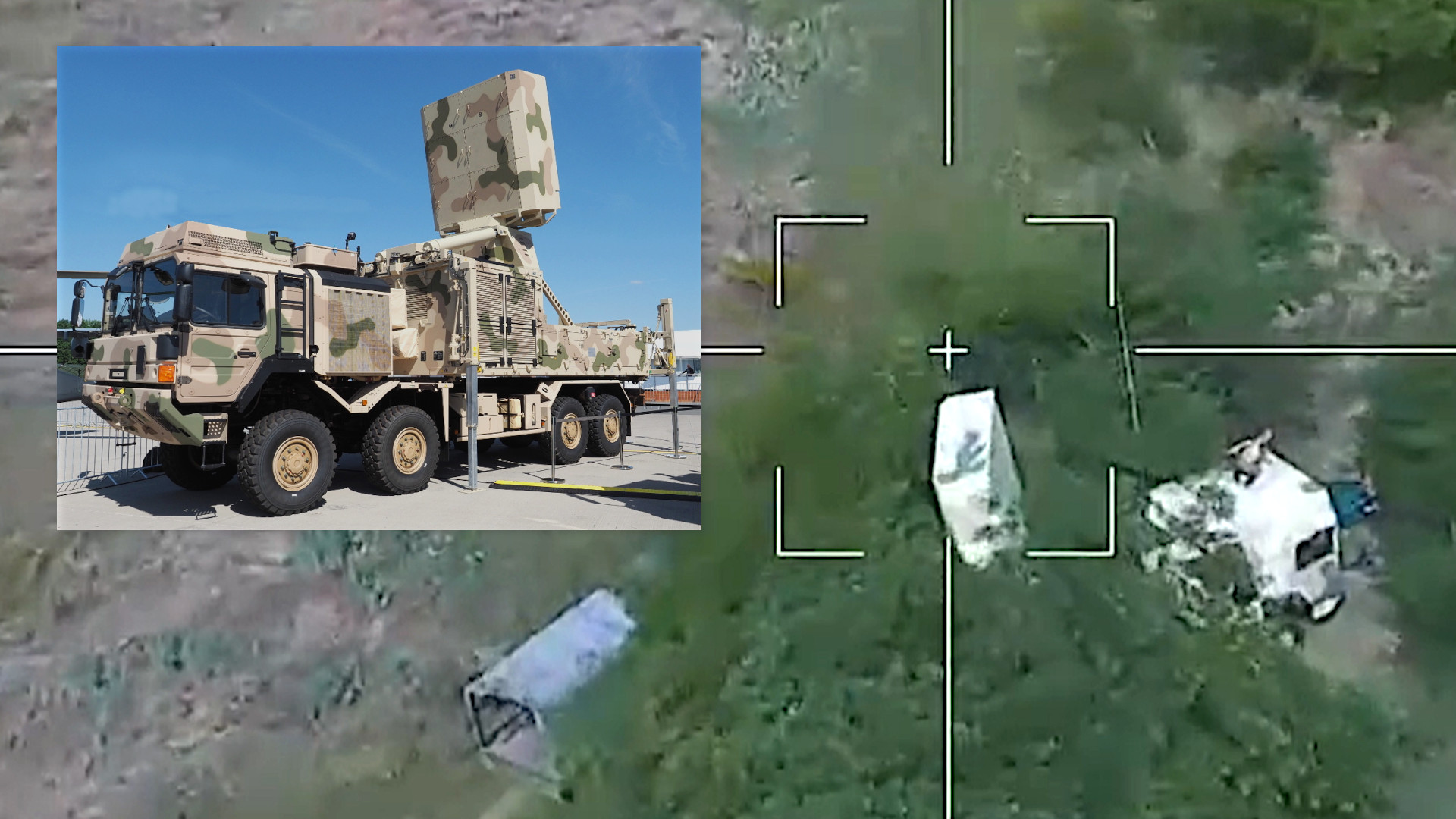Video footage has emerged that appears to show a Russian loitering munition, or kamikaze drone, attacking a Hensoldt TRML-4D truck-mounted radar belonging to the Ukrainian armed forces. This radar is a key component of the IRIS-T SLM surface-to-air missile system and may be the only one of its kind delivered to Ukraine to date. Additional images show a launcher associated with this system with the insinuation that it was also struck.
The imagery of the apparent Russian strikes on Ukrainian IRIS-T SLM systems appeared on social media earlier today. Russian forces are said to have carried these out using Lancet-series loitering munitions.
The full extent of any damage to the TRML-4D seen in the video from the apparent strike is unclear. The footage is of low quality, but there are some indications that the radar array may have been hit. This could also just be a trick of the light or the result of other differences in perspective.

In addition, an individual is seen on top of the radar truck’s cab right before the kamikaze drone’s apparent impact it. Other nearby personnel and another truck are then seen racing away while the TRML-4D remains immobile in the clips toward the end.

Regardless, radars are notoriously fragile and it would not necessarily take much damage to affect a mission kill, putting the system out of action for at least some amount of time, even if it is repairable.
There are only still images available of the claimed strike on the IRIS-T SLM launcher, seen below, which look to have been captured before the loitering munition hit. This makes it difficult to independently assess any damage that the vehicle might have sustained.
There is also the question of where these vehicles would have been to be targeted by Russian Lancets. Variants of these loitering munitions have relatively short ranges between 40 and 70 kilometers (around 25 to 43 miles), according to Russian state media.
If the TRML-4D, in particular, was damaged, this could be especially significant given how few of them are in Ukrainian hands – possibly just one – at all.
At the time of writing, the German government’s official website covering the country’s military aid to Ukraine lists one TRML-4D as having been delivered. That country has pledged seven more, which it says have not yet been transferred.
It is worth noting that Germany also says it has sent two complete IRIS-T SLM systems, which one would assume would include radars. It is certainly possible that the official figures are out of date or otherwise inaccurate. There have been reports that German authorities would deliver two more of these radars early this year.
In addition, no other country has announced plans to send these radars, or the IRIS-T SLM systems they’re associated with, to Ukraine, at least publicly. So, the total number of TRML-4D radars in Ukraine is at best small.

The TRML-4D, which was only first unveiled in 2018, is a very modern road-mobile active electronically scanned array C-band air surveillance radar. It also has a high-fidelity tracking functionality that obviates the need for a separate fire control radar when used as part of a surface-to-air missile system like IRIS-T. As such, the other components of a typical IRIS-T battery using the TRML-4D are three launcher vehicles and a mobile command post. Ukraine received its first IRIS-T SLM system from Germany in October 2022.

If the TRML-4D in video has been put out of action, even temporarily, it is not clear what that might mean for Ukraine’s IRIS-T SLMs. There are other air defense radars in Ukrainian service, including ones it has received from the United States, but it is unclear how readily compatible they might be, even under exigent circumstances, with the IRIS-T SLM and how and where it is being used in Ukraine.
Whatever the case, this apparent Lancet strikes on the TRML-4D and other IRIS-T system components underscores the importance of Western-supplied air defense assets to Ukraine and Russia’s unsurprising desire to neutralize them. The significance of foreign assistance when it comes to defending Ukraine’s skies has only become more pronounced amid recent reports that its stocks of Soviet-era surface-to-air missiles have begun to run low after more than a year of all-out fighting with Russian forces.
Ukrainian surface-to-air missile systems, as well as other air defense assets, are routinely called into action across the country, including around the capital Kyiv, to defend against Russian missiles, drones, and other aerial threats. Ukraine’s ground-based air defenses have been essential to preventing Russia’s military from gaining air superiority, which has significantly hampered the invading forces.
Ukrainian officials say IRIS-T SLM has been particularly effective, especially against cruise missiles and drones, claiming it has achieved a 90 percent hit rate since it entered service in the country.

No matter what the exact circumstances surrounding the imagery of the strikes on elements of Ukraine’s IRIS-T SLM systems turn out to be, or how damaged or not they are, it should be noted that no weapon systems or other military equipment Ukraine have received from its international partners are indestructible. As noted, it makes good sense for Russia to target important assets like air defense radars and losses will inevitably occur.
All told, what exactly happened to the TRML-4D radar in the video, which may be the only one Ukraine has for now, remains to be seen.
Contact the author: joe@thedrive.com
